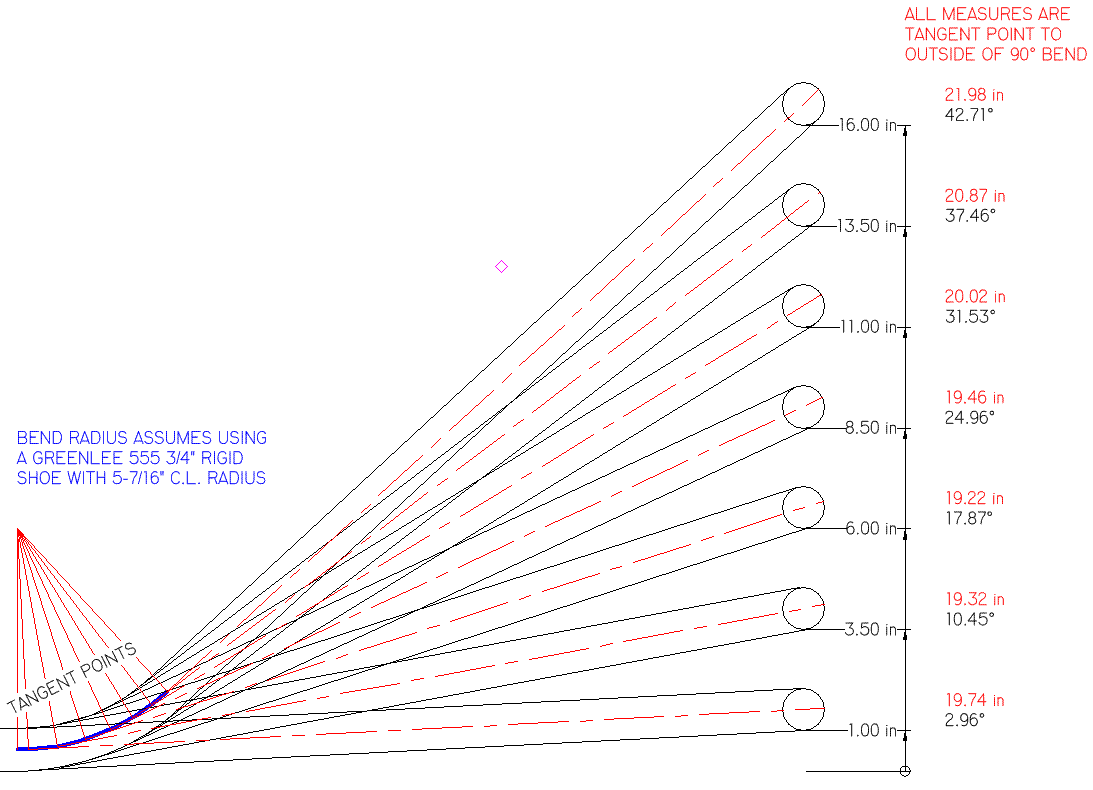Is Smart’s picture exactly what your doing? I think we can all play along if this is the case!
But I didn’t do any math and I don’t have any tables of the 5-7/16” shoe bender.
What’s bothering me is the fact of where the tangent points are set up in Smart’s Drawing. That point is set on the center of the conduit.
I believe and I might be totally wrong but will stick my neck out to say that the tangent points should be set to the bottom of the conduit. Yes I realize that that certain measurements need to be met, But math wise you can’t rationally use the sine/Cos equation, one has to use the bottom and not the center of conduit to get past the 1”, 3.5”, etc increments, as the drawing is presented, or as your trying to apply the offset and the sine|cos equations…
Or to say another way;
Or one has to use 1” plus the center line of conduit as to use the tangent point as shown in Smart’s picture… to get the desired result. JMO
To bend these conduits there is nothing else to calculate, other than subtracting the 0? deduct so as to place one's bend mark for the kick. However, if the need to thread the kick end of the conduit before bending the kick is necessary or desired, retrained' will have to determined developed length through the kick bend before actually bending it.
Let's run through bending the greatest kick conduit as if the kick end was 36" (i.e. 16" more than where the kick ends going in that direction).
First, stick the coupling'd end of the conduit in the bender with the coupling against the hook. Bend a minimum stub 90?. Amid bending, measure how much conduit is used in the bend. One way to do this for instance, when the conduit is just barely snugged, put a mark 20" (any amount more than what will be used in the bend) away from the roller. Stop the bender say at +92? (+2? spring back allowance). Measure from mark to roller and subtract this measure from the original 20". The result is how much conduit is used in a 90? bend.
Now put the conduit with 90? bend to your square on the bending table, and measure out 3" inches short of the 22" [21.98"] in the diagram. The 3" is the 0? bend deduct. Put conduit back in bender with the 90? to the left. Align the kick bend mark to the face of the hook, snug it up, orient the 90? so it is 90? to the plane of the bender. Here you have a choice of measuring a near 43? bend, or measuring +16 inches off the floor or bending table to the stub, or both (allowing a little overbend to compensate for spring back).
That would complete the bending... BUT... most stand, power threaders will not easily accommodate through it's barrel a cut and thread 16" out from a 43? bend (though a power pony/manual threader is an option when available).
The thing to do here is cut and thread before bending the kick. So when we layout for the kick, we mark both the tangent point and bend mark. We need to determine where the other tangent point is. For a bend of 42.7?, divide by 90?, and multiply by the amount of conduit used in the 90? bend determined earlier, let's say it was 8-3/4". This gives us the amount of conduit that will be used in a 42.7? bend... which figures to be a heavy 4-1/8". Mark this distance plus the 16" and that is where you'd cut and thread before bending the kick.



